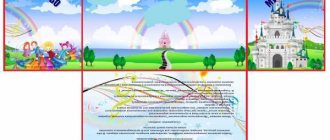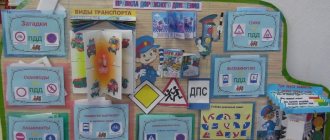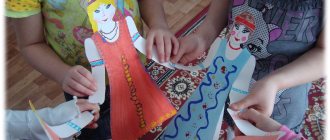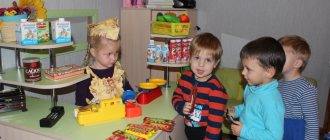In the modern world, environmental education is becoming one of the priority areas of preschool educational institutions. Its goal is to form a personality capable of caring for nature, living in harmony with it, and being aware of the consequences of their actions in relation to the environment. To present these important points in the most exciting way possible and avoid edification, educators put knowledge into playful forms and use unusual aids, for example, a lapbook.
- 2 Information content of the laptop “Ecology”
2.1 A selection of proverbs and sayings on environmental topics - 2.2 A selection of riddles on an environmental theme
- 2.3 A selection of poems on an environmental theme
- 3.1 Photo gallery: ready-made lapbook spreads on ecology
For what age is an ecological lapbook suitable?
Although preschoolers already receive knowledge about nature, the interaction of living organisms with each other and the environment in the junior group, it is still better to offer an environmental lapbook to children in the senior group . After all, the main goal of this manual is to convey to the children the idea that they need to take care of their home planet in order to avoid serious problems.
On the Internet you can find the development of environmental lapbooks for middle and even younger groups. However, in essence, they are a combination of the topics “Seasons”, “Natural Phenomena”, “Forest Animals and Plants”, “Healthy and Poisonous Mushrooms and Berries”. It is advisable to directly introduce the topic of nature conservation to children at an older preschool age: they approach it more consciously, for example, they already understand what food chains, non-renewable resources, the Red Book, etc. are.
An ecological lapbook that addresses global problems of humanity is best offered to children in early preschool age.
The specific objectives of the ecological lapbook are as follows:
- Give an idea of the science of ecology.
- To instill in preschoolers a caring attitude towards nature.
- Establish rules of behavior in nature.
- Give an idea of the Red Book and medicinal plants.
Older preschoolers can already understand what kind of science ecology is
Pupils of the senior and preparatory groups can actively participate in filling out the lapbook, for example, coloring cards prepared by the teacher.
Download ready-made templates for environmental laptops.
In the lapbook: natural resources, living and inanimate nature, environmental game “What you can and cannot do in nature,” environmental proverbs
Print out a lapbook on the topic “Garbage”
In the lapbook: sorting waste for subsequent recycling, the time frame for decomposition of waste in pictures.
Photos of homemade lapbooks in author’s blogs on the MAAM portal
Contained in sections:
- Ecology. Didactic games and environmental aids
- Garbage. Activities, scenarios, crafts on an environmental theme
- Red Book
- Nature, ecology. Planet Earth
- Lapbook. Interactive folder
Showing publications 1-10 of 207. All sections | Lapbook on ecology. Environmental themed folders
New
Photo
The best
Lapbook “Take care of nature”
Environmental education of preschoolers according to the Federal State Educational Standard is a continuous process of development of children, aimed at developing in them an ecological culture , which is expressed in the presence of: sustainable knowledge about nature and the relationships existing in it; respect for nature;...
Lapbook on ecology “You and I are friends of nature”
In the modern world, environmental education is becoming one of the priority areas of preschool educational institutions. Its goal is to form a personality capable of caring for nature, living in harmony with it, and being aware of the consequences of their actions in relation to the environment. To…
Features of the design of a laptop on ecology
When designing a lapbook, the teacher should use more interesting details that will attract children's attention. First of all, you need to come up with a bright name for the manual, for example, the following options are suitable:
- "Young ecologists";
- "Take care of your planet";
- “Nature is our home”;
- Love and protect nature";
- "Protect the environment".
The “face” of a lapbook is its cover. On it you can depict planet Earth with human features (smiling, with hair).
Interesting cover elements immediately attract children's attention
The edges of the cover can be beautifully decorated with green ribbons.
You need to use more decorative elements in the design - children always like this
You can design the cover in two parts. The first is in warm colors, depicting smiling animals, and the second will be black and white, gloomy, with bare trees, as if a warning of what can happen if we do not take care of nature.
Great idea to make a warning cover
The very definition of ecology within the manual can be given in the form of a three-dimensional flower.
The theme of the lapbook favors floral elements
It is worth placing books in a lapbook (small or medium-sized) that children love to leaf through. For example, this could be “Medicinal Plants” or “Types of Resources”.
It’s good to include a small book or even two in a lapbook - children are interested in leafing through them
Kids always love folding envelopes. You can make two options: “Why the planet is happy” and “Why the planet is sad.” The first will be made in warm colors, the second in cold colors.
Children love opening and closing the petals of flower-like envelopes
By opening the “petals”, the children will be able to see what exactly makes the planet happy or upset.
Having opened the envelope, the guys will see what exactly upsets the Earth.
The original design element is an envelope tied with ribbons.
The very process of untying an envelope to find out its contents fascinates children
Another interesting detail is a rotating disk, for example, on the theme “Who eats what”. The large circle depicts animals and birds, and the small circle depicts their food. By rotating the circle, children match the pictures.
By rotating the upper movable circle made of cardboard, the child will select the animal for a certain food
Be sure to use folding tapes. For example, one can depict objects of living nature, the other - inanimate.
An original design element - folding ribbons
Photo gallery: ready-made lapbook spreads on ecology
The basis of the laptop is cardboard covered with wallpaper.
In the central part of the lapbook, the envelopes are made in the same style - against the background of the blue sky
The laptop is quite large in size and has many interesting elements.
The laptop is depicted against the background of a forest landscape, it is decorated with decorative elements in the form of a leaf, flower, dragonfly
The laptop contains a lot of visuals in an unusual form
A bright element of the lapbook is a large green tree
Lapbook on ecology for elementary school students
Methodical manual “Lapbook “Living and inanimate nature.
Ecology" This work will be of interest to primary school teachers, additional education teachers, preschool teachers, and parents. The content of the material and the design of the book can be changed to suit the age range of children.
Goals: to consolidate children’s ideas about nature in general, about the differences and signs of living and inanimate nature, about ecology. Objectives: 1. To give students an initial idea of nature as a whole, of living and inanimate nature; mastering the basics of environmental literacy, basic rules of moral behavior in the world of nature and people, norms of health-preserving behavior in the natural and social environment; identify connections between living and inanimate nature. 2. Mastery of the logical actions of comparison, analysis, synthesis, generalization, establishing analogies and cause-and-effect relationships, constructing reasoning, and referring to known concepts. 3. Fostering interest and respect for nature. 4. Development of skills of cooperation with adults and peers in different social situations, the ability not to create conflicts and find ways out of controversial situations. 5. Mastering ways to solve problems of a creative and exploratory nature. Contents of the teaching aid: 1. Game “What do plants need?” 2. Game “What do animals need?” 3. Game “Living and inanimate nature” 4. Signs of living nature. 5. Riddles about nature. 6. Game “What does nature give us?” 7. Ecological game “Take care of nature! You can’t do this!” 8. Food chains. The laptop was made together with 2nd grade students during a reinforcement lesson. The children, together with the teacher, were engaged in selecting materials and dividing them into main sections. The children also painted the necessary materials themselves, selected riddles, made pockets, and did the decoration. To work more efficiently, students were divided into creative groups that did their part of the work. Here's what we got:
We recommend watching:
Ecological fairy tale for primary school. Spring flowers Ecological game for 4th grade Ecological action for primary schoolchildren Creative stories for primary school children. Tales of the Lena River
Similar articles:
Open lesson-project on the world around us, grade 3
Class hour, 2nd grade. Environmental education
Ecological class hour in grades 3 - 4
Extracurricular activities on ecology for primary schoolchildren
Game lessons on ecology for primary school. Kinds. Methodology of organization and conduct






